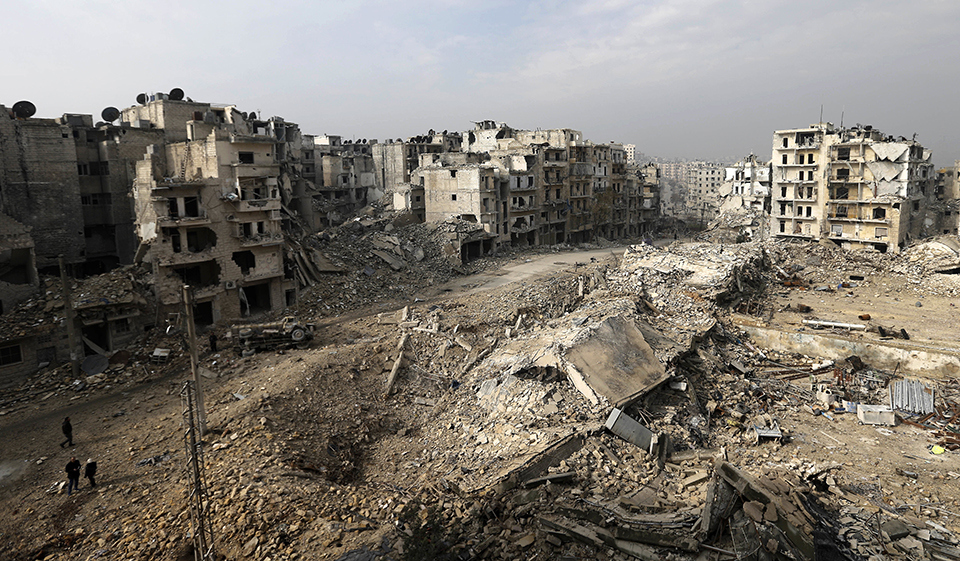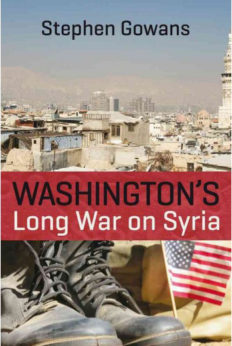
“Are wars of aggression, wars for the conquest of colonies, then just big business? Yes, it would seem so, however much the perpetrators of such national crimes seek to hide their true purpose under banners of high sounding abstractions and ideals.”
This quote from Norman Bethune is the frontispiece for Washington’s Long War on Syria by Stephen Gowans, just out from Baraka Books.
The book is less an account of the “Syrian Spring” and the civil war that ensued from 2011 to today, but rather “more an examination of the historic processes that shaped those events,” writes Gowans. He describes the book as “an inquiry into the three political forces which have vied for control of the Syrian state from the end of World War II: secular Arab nationalism (with a particular emphasis on the role of Ba’athism), Sunni Islam, and U.S. imperialism.”
Clearly written with extensive documentation, Gowans’ book calls into question just about every tenet of present U.S. foreign policy: that the U.S. is fighting for “freedom and democracy” in Syria; that there is a civil war between the Ba’athist Assad regime and a “democratic opposition”; and that the “regime change” called for in Syria has anything in common with self-determination for the Syrian people.
He concludes that Washington’s allies in the fight against the Syrian government are Islamists, not democrats, and the Islamists’ goal is to create a Sunni Islamic state. Even the Free Syrian Army, touted in the early days of the rebellion as a liberal democratic movement, not only included Islamists, but was Islamist-dominated.
The Ba’athist movement was founded in response to the defeat of Arab nations by Israel in the 1948 Arab-Israeli War. It stood for three principles: unity of the Arab nation; freedom from foreign domination; and Arab socialism. In contrast to the Gulf regimes, its aim was to overcome the Arab world’s colonial legacy of underdevelopment through state planning and modernization benefitting the Arab people.
Animated by Egyptian president Nasser’s nationalizations in 1956, as well as the ongoing Palestinian struggle, the Ba’athist movement’s commitment to unity flowed from the view that existing differences among Arabs were of no political significance; identification as Arabs was paramount.
This was at variance with Marxist ideology and the Communist Parties that espoused it. They too advocated for self-determination for oppressed nations under imperialism, but based their strategy on a class analysis. This response to imperialism is also at odds with political Islam, which defines Islamic identity, rather than ethnicity, as the political organizing principle of the Arab world.
Much to the alarm of Wall Street, the Ba’athist regimes that came to be established, such as Muammar Gaddafi in Libya in 1969, Saddam Hussein in Iraq in 1979, Hafez el-Assad in Syria in 1971 (succeeded by his son, Bashar al-Assad, in 2000), used their countries’ oil wealth not to benefit Wall Street investors, but to benefit the Arab masses. The major structural reforms enacted stood in sharp contrast to the economic policies of U.S.-compliant regimes like Saudi Arabia, Egypt, Jordan, the Gulf Arab states, and Pakistan. These absolute monarchies and theocracies relied on protection from the U.S. against their own people in exchange for providing military bases for the Pentagon and assuring oil profits to U.S. corporations.

Arab unity was seen as a threat by U.S. imperialism, which has historically relied on divide-and-conquer in the Middle East to rule. But the fact that Ba’athist regimes were using their countries’ oil to improve the standard of living of their people gave the call for Arab unity even more appeal.
Gowans writes of a CIA plot as early as 1953 to assassinate leading communists and Ba’athists in the Syrian government. The plot was masterminded by Kermit Roosevelt, a nephew of President Franklin Roosevelt, who also spearheaded the overthrow of the nationalist Mosaddegh regime in Iran in 1953. Part of the plot was to instigate uprisings throughout Syria, enlisting the Muslim Brotherhood as well as paramilitary groups to wage a civil war inside the country.
Although never enacted, the scenario bears an eerie resemblance to the 2011 uprising, including the secret funding of a “Free Syria Committee” similar to the Free Syria Committee that emerged in 2011.
To be sure, the Muslim Brotherhood hated secular Arab nationalism. And when the Brotherhood seized control of the city of Hama in 1980, for instance, murdering every Ba’athist official in the area, Syrian security forces responded in self-defense. Gowans also discusses Syria’s unsuccessful attempts to conciliate Islamists through various measures over the years.
Gowans cites research that an invasion of U.S. forces into Syria was contemplated following the U.S. occupation of Iraq in 2003. The unanticipated task of pacifying ethnic rivalries it had inflamed through “deba’athification” militated against the move. In addition to outlawing the Ba’athist party and blacklisting all its members, U.S. Proconsul Bremer immediately took measures to topple Iraq’s public-sector economy and create new profit-making investments for U.S. businesses.
According to WikiLeaks, by 2005 the U.S. had come to see the Muslim Brotherhood as the best hope of bringing down the regime. Gowans documents how in 2011 “Syria Spring” protests by some Syrians around economic demands were rapidly eclipsed by the Muslim Brotherhood and their agenda. The Assad regime clamped down on the increasingly violent protests.
The situation was complicated for the U.S., however, by the fact that it was funding and training insurgents fighting alongside and often enmeshed with al-Qaeda and al-Nusra, offshoots of the Muslim Brotherhood. Concerned about the fallout if it was discovered that the U.S. was allying with groups which stood for a Saudi-style absolute monarchy, and which had ties to the 9/11 bombing of the World Trade Center, the U.S. pushed back with the myth of a “moderate opposition.”
The search for a “moderate opposition” would end ignominiously with the admission in 2015 by a U.S. general that after spending $500 million in a program designed to develop such an opposition, the Pentagon could point to only four (!) such “moderate” fighters.
Washington’s Long War on Syria is particularly adept in its exposure of Washington’s disinformation campaign, the methods by which imperialism’s designs are carefully hidden, and the real issues obscured.
Gowans documents the promulgation of reports about “weapons of mass destruction” and chemical weapons over the years (some either dubious or completely false), while the war crimes and brutality of the regimes the U.S. supports, such as Saudi Arabia and Israel, get a free pass. He describes the U.S. fanning the flames of ethnic rivalry in Syria by funding sectarian Islamist organizations in the name of a “democratic struggle.” He shows the U.S. painting Assad as a dictator propped up by and benefitting a narrow Alawite religious minority, when his real basis of support is as a secular Arab nationalist. And Gowans includes the importance of keeping the U.S. public ignorant of the history of Syria and U.S. imperialism’s role.
Gowans discusses the bewilderment of western visitors about the relative popularity of the Assad regime inside Syria, and locates a big reason for this bewilderment in the continual stream of demonizing accounts regarding the Assad regime. But another reason for this popularity is that the negative results of “regime change” are becoming clear to many Syrians.
In the new puppet regimes of Libya and Iraq, oil profits now flow freely to Wall Street, and right-wing religious fundamentalism rides high. If the Assad regime retains some degree of popularity, it is because many Syrians see repression of increasingly violent protests by Islamists as preserving a secular Arab nationalist regime, with rights for religious minorities, some degree of independence from Wall Street and benefits from state planning.
The point of Gowans’ book in opposing U.S. intervention in Syria is not to paint Assad as something he is not. Gowans points out Ba’athist Assad (and for that matter, Hussein and Gaddafi) have in the past also brutally repressed the just struggles of workers’ organizations, national liberation fighters, and communists.
The central point is that without an understanding of the divide-and-conquer role of imperialism, and particularly its interaction with political Islam and Arab nationalism, the developments in Syria are simply not comprehensible.
Behind Washington’s rhetoric of a war for “freedom” and “democracy” in Syria lie the same forces for profit and plunder that overthrew Iran’s Mosaddegh, Libya’s Gaddafi, and Iraq’s Hussein. Those same forces, on behalf of the banks and corporations, target working people in the U.S today.
Washington’s Long War on Syria exposes the real story behind the “noble ideas” that Washington invokes to wage its wars around the world, the burning truth that Norman Bethune spoke of.
Washington’s Long War on Syria
By Stephen Gowans
Baraka Books







